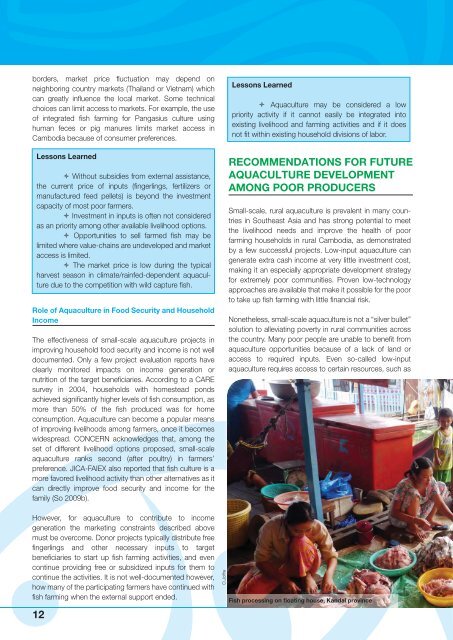Aquaculture for the Poor in Cambodia - World Fish Center
Aquaculture for the Poor in Cambodia - World Fish Center
Aquaculture for the Poor in Cambodia - World Fish Center
You also want an ePaper? Increase the reach of your titles
YUMPU automatically turns print PDFs into web optimized ePapers that Google loves.
orders, market price fluctuation may depend on<br />
neighbor<strong>in</strong>g country markets (Thailand or Vietnam) which<br />
can greatly <strong>in</strong>fluence <strong>the</strong> local market. Some technical<br />
choices can limit access to markets. For example, <strong>the</strong> use<br />
of <strong>in</strong>tegrated fish farm<strong>in</strong>g <strong>for</strong> Pangasius culture us<strong>in</strong>g<br />
human feces or pig manures limits market access <strong>in</strong><br />
<strong>Cambodia</strong> because of consumer preferences.<br />
Lessons Learned<br />
Without subsidies from external assistance,<br />
<strong>the</strong> current price of <strong>in</strong>puts (f<strong>in</strong>gerl<strong>in</strong>gs, fertilizers or<br />
manufactured feed pellets) is beyond <strong>the</strong> <strong>in</strong>vestment<br />
capacity of most poor farmers.<br />
Investment <strong>in</strong> <strong>in</strong>puts is often not considered<br />
as an priority among o<strong>the</strong>r available livelihood options.<br />
Opportunities to sell farmed fish may be<br />
limited where value-cha<strong>in</strong>s are undeveloped and market<br />
access is limited.<br />
The market price is low dur<strong>in</strong>g <strong>the</strong> typical<br />
harvest season <strong>in</strong> climate/ra<strong>in</strong>fed-dependent aquaculture<br />
due to <strong>the</strong> competition with wild capture fish.<br />
Role of <strong>Aquaculture</strong> <strong>in</strong> Food Security and Household<br />
Income<br />
The effectiveness of small-scale aquaculture projects <strong>in</strong><br />
improv<strong>in</strong>g household food security and <strong>in</strong>come is not well<br />
documented. Only a few project evaluation reports have<br />
clearly monitored impacts on <strong>in</strong>come generation or<br />
nutrition of <strong>the</strong> target beneficiaries. Accord<strong>in</strong>g to a CARE<br />
survey <strong>in</strong> 2004, households with homestead ponds<br />
achieved significantly higher levels of fish consumption, as<br />
more than 50% of <strong>the</strong> fish produced was <strong>for</strong> home<br />
consumption. <strong>Aquaculture</strong> can become a popular means<br />
of improv<strong>in</strong>g livelihoods among farmers, once it becomes<br />
widespread. CONCERN acknowledges that, among <strong>the</strong><br />
set of different livelihood options proposed, small-scale<br />
aquaculture ranks second (after poultry) <strong>in</strong> farmers’<br />
preference. JICA-FAIEX also reported that fish culture is a<br />
more favored livelihood activity than o<strong>the</strong>r alternatives as it<br />
can directly improve food security and <strong>in</strong>come <strong>for</strong> <strong>the</strong><br />
family (So 2009b).<br />
Lessons Learned<br />
<strong>Aquaculture</strong> may be considered a low<br />
priority activity if it cannot easily be <strong>in</strong>tegrated <strong>in</strong>to<br />
exist<strong>in</strong>g livelihood and farm<strong>in</strong>g activities and if it does<br />
not fit with<strong>in</strong> exist<strong>in</strong>g household divisions of labor.<br />
RECOMMENDATIONS FOR FUTURE<br />
AQUACULTURE DEVELOPMENT<br />
AMONG POOR PRODUCERS<br />
Small-scale, rural aquaculture is prevalent <strong>in</strong> many countries<br />
<strong>in</strong> Sou<strong>the</strong>ast Asia and has strong potential to meet<br />
<strong>the</strong> livelihood needs and improve <strong>the</strong> health of poor<br />
farm<strong>in</strong>g households <strong>in</strong> rural <strong>Cambodia</strong>, as demonstrated<br />
by a few successful projects. Low-<strong>in</strong>put aquaculture can<br />
generate extra cash <strong>in</strong>come at very little <strong>in</strong>vestment cost,<br />
mak<strong>in</strong>g it an especially appropriate development strategy<br />
<strong>for</strong> extremely poor communities. Proven low-technology<br />
approaches are available that make it possible <strong>for</strong> <strong>the</strong> poor<br />
to take up fish farm<strong>in</strong>g with little f<strong>in</strong>ancial risk.<br />
None<strong>the</strong>less, small-scale aquaculture is not a “silver bullet”<br />
solution to alleviat<strong>in</strong>g poverty <strong>in</strong> rural communities across<br />
<strong>the</strong> country. Many poor people are unable to benefit from<br />
aquaculture opportunities because of a lack of land or<br />
access to required <strong>in</strong>puts. Even so-called low-<strong>in</strong>put<br />
aquaculture requires access to certa<strong>in</strong> resources, such as<br />
However, <strong>for</strong> aquaculture to contribute to <strong>in</strong>come<br />
generation <strong>the</strong> market<strong>in</strong>g constra<strong>in</strong>ts described above<br />
must be overcome. Donor projects typically distribute free<br />
f<strong>in</strong>gerl<strong>in</strong>gs and o<strong>the</strong>r necessary <strong>in</strong>puts to target<br />
beneficiaries to start up fish farm<strong>in</strong>g activities, and even<br />
cont<strong>in</strong>ue provid<strong>in</strong>g free or subsidized <strong>in</strong>puts <strong>for</strong> <strong>the</strong>m to<br />
cont<strong>in</strong>ue <strong>the</strong> activities. It is not well-documented however,<br />
how many of <strong>the</strong> participat<strong>in</strong>g farmers have cont<strong>in</strong>ued with<br />
fish farm<strong>in</strong>g when <strong>the</strong> external support ended.<br />
12<br />
O.Joffre<br />
<strong>Fish</strong> process<strong>in</strong>g on float<strong>in</strong>g house, Kandal prov<strong>in</strong>ce
















